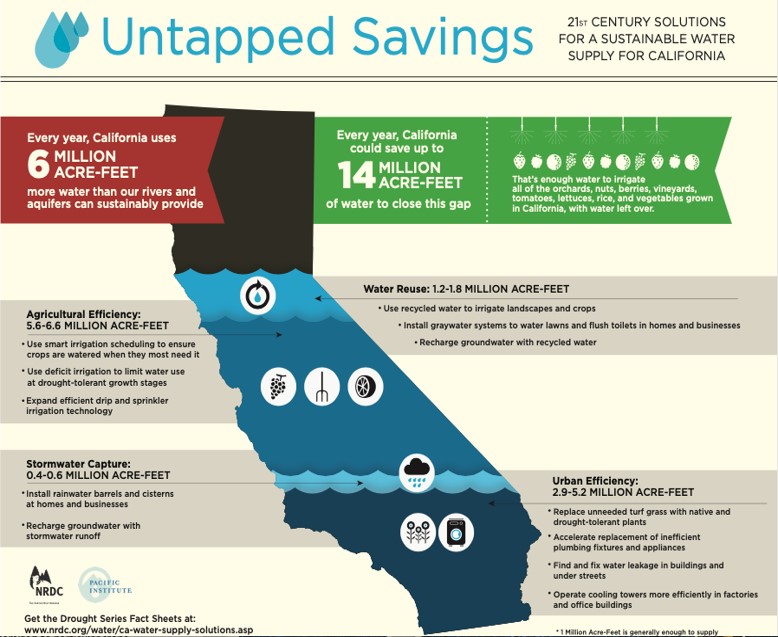California’s rivers and aquifers cannot sustainably provide all the water the state has promised over the years. With growing climate change and a drought-prone future, water conservation can help preserve the supply we have and help Californians live sustainably within our water means.
Conservation means using as little water as possible to supply life’s needs, and putting the water we do have to appropriate and sustainable uses. Conservation can be done in many ways and can help attain long-term water security. Conservation is our cheapest “water supply”.
All sectors can contribute to conserving up to 14 million acre-feet (maf) each year—about one third of California’s current agriculture and urban/suburban applied water use. Key sectors are shown in the 2014 NRDC infographic below.
Agriculture uses about 80% of California’s “developed” water supply (water delivered for agriculture and urban/suburban use). According to DWR, California agriculture uses roughly 34 million acre-feet/year.
Conservation/efficiency could reduce agricultural water use by 5.6 to 6.6 maf, which is about 16-22% of agricultural water use. Conservation methods include irrigation methods such as “smart” watering (only when needed), “deficit” (limiting water during certain non-critical growth stages), and efficient use of new technology. Drought-resistant crops can replace thirsty varieties. Healthy soil practices (including cover crops) can result in more crop yield with less water, and save farmers money. Recycled water can be customized to particular crops, providing multiple benefits from a given amount of water. Hydroponics and aeroponics use much less water than in-ground farming methods, and have potential for expansion
Urban/Suburban (including residential, business and industrial) uses about 6 to 9 maf per year. We could save a large portion – 2.9 to 5.2 maf – through increased efficiency and through lifestyle/habit modification. Because outdoor watering accounts for 25-80% of residential water use, drought-tolerant plantings can replace lawns and reduce water use (and bills). Indoors, we can replace water-wasting toilets, faucets, showerheads and washers.
Using these strategies, Californians reduced per capita water use from 231 gallons per day in 1990 to 180 gallons per day in 2010. In 2015, per capita use fell to 146 gallons per day in response to drought-related conservation requirements.
Stormwater Capture: Hundreds of thousands of acre-feet of water, if captured and used, could water crops and gardens, and replenish aquifers (groundwater). Aquifer storage has many benefits over surface reservoirs. Groundwater recharge is cheaper, and aquifers can store significantly more water: groundwater/aquifer recharge could store 850 maf to 1.3 billion acre-feet, while total cumulative storage capacity of California’s major reservoirs is only 50 maf.
Water Reuse: Getting a second or third use out of water, including graywater and even blackwater, could mean over a million more acre-feet of water available for local needs.
As we face less available water with climate change, some kinds of investment can help us live within our water means, but conservation—just through our changed behavior—gives us “free” water.
Meg Giberson J.D., Member LWVC Water Committee

